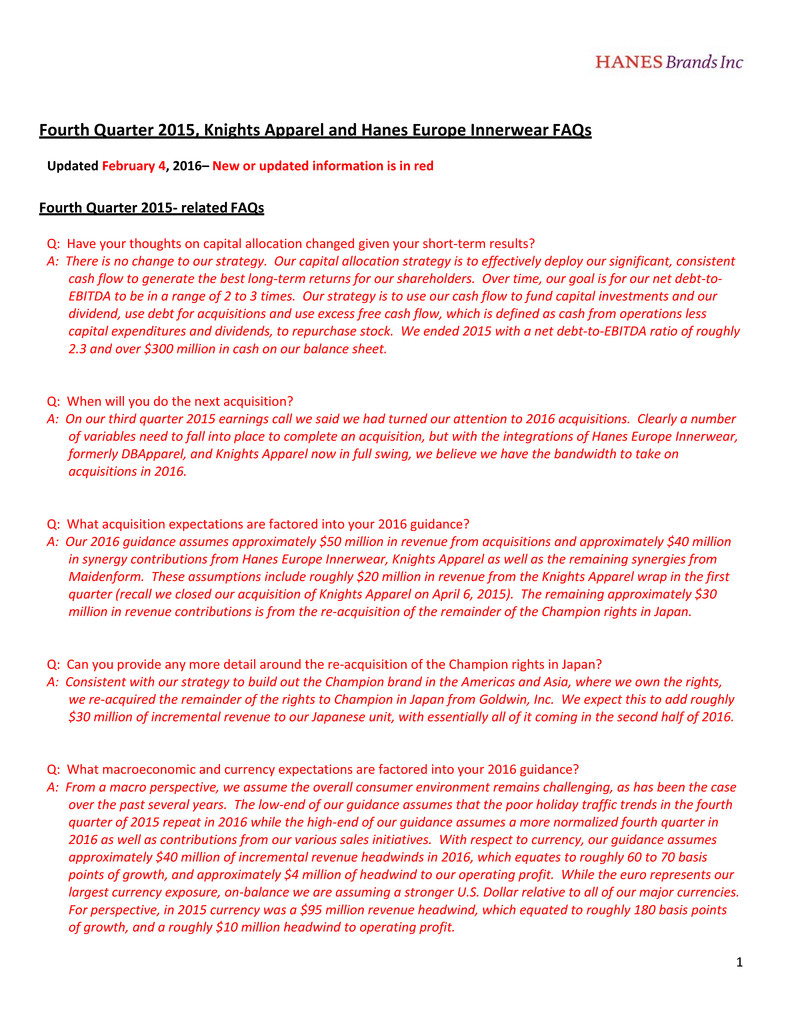
1 Fourth Quarter 2015, Knights Apparel and Hanes Europe Innerwear FAQs Updated February 4, 2016– New or updated information is in red Fourth Quarter 2015‐ related FAQs Q: Have your thoughts on capital allocation changed given your short‐term results? A: There is no change to our strategy. Our capital allocation strategy is to effectively deploy our significant, consistent cash flow to generate the best long‐term returns for our shareholders. Over time, our goal is for our net debt‐to‐ EBITDA to be in a range of 2 to 3 times. Our strategy is to use our cash flow to fund capital investments and our dividend, use debt for acquisitions and use excess free cash flow, which is defined as cash from operations less capital expenditures and dividends, to repurchase stock. We ended 2015 with a net debt‐to‐EBITDA ratio of roughly 2.3 and over $300 million in cash on our balance sheet. Q: When will you do the next acquisition? A: On our third quarter 2015 earnings call we said we had turned our attention to 2016 acquisitions. Clearly a number of variables need to fall into place to complete an acquisition, but with the integrations of Hanes Europe Innerwear, formerly DBApparel, and Knights Apparel now in full swing, we believe we have the bandwidth to take on acquisitions in 2016. Q: What acquisition expectations are factored into your 2016 guidance? A: Our 2016 guidance assumes approximately $50 million in revenue from acquisitions and approximately $40 million in synergy contributions from Hanes Europe Innerwear, Knights Apparel as well as the remaining synergies from Maidenform. These assumptions include roughly $20 million in revenue from the Knights Apparel wrap in the first quarter (recall we closed our acquisition of Knights Apparel on April 6, 2015). The remaining approximately $30 million in revenue contributions is from the re‐acquisition of the remainder of the Champion rights in Japan. Q: Can you provide any more detail around the re‐acquisition of the Champion rights in Japan? A: Consistent with our strategy to build out the Champion brand in the Americas and Asia, where we own the rights, we re‐acquired the remainder of the rights to Champion in Japan from Goldwin, Inc. We expect this to add roughly $30 million of incremental revenue to our Japanese unit, with essentially all of it coming in the second half of 2016. Q: What macroeconomic and currency expectations are factored into your 2016 guidance? A: From a macro perspective, we assume the overall consumer environment remains challenging, as has been the case over the past several years. The low‐end of our guidance assumes that the poor holiday traffic trends in the fourth quarter of 2015 repeat in 2016 while the high‐end of our guidance assumes a more normalized fourth quarter in 2016 as well as contributions from our various sales initiatives. With respect to currency, our guidance assumes approximately $40 million of incremental revenue headwinds in 2016, which equates to roughly 60 to 70 basis points of growth, and approximately $4 million of headwind to our operating profit. While the euro represents our largest currency exposure, on‐balance we are assuming a stronger U.S. Dollar relative to all of our major currencies. For perspective, in 2015 currency was a $95 million revenue headwind, which equated to roughly 180 basis points of growth, and a roughly $10 million headwind to operating profit.
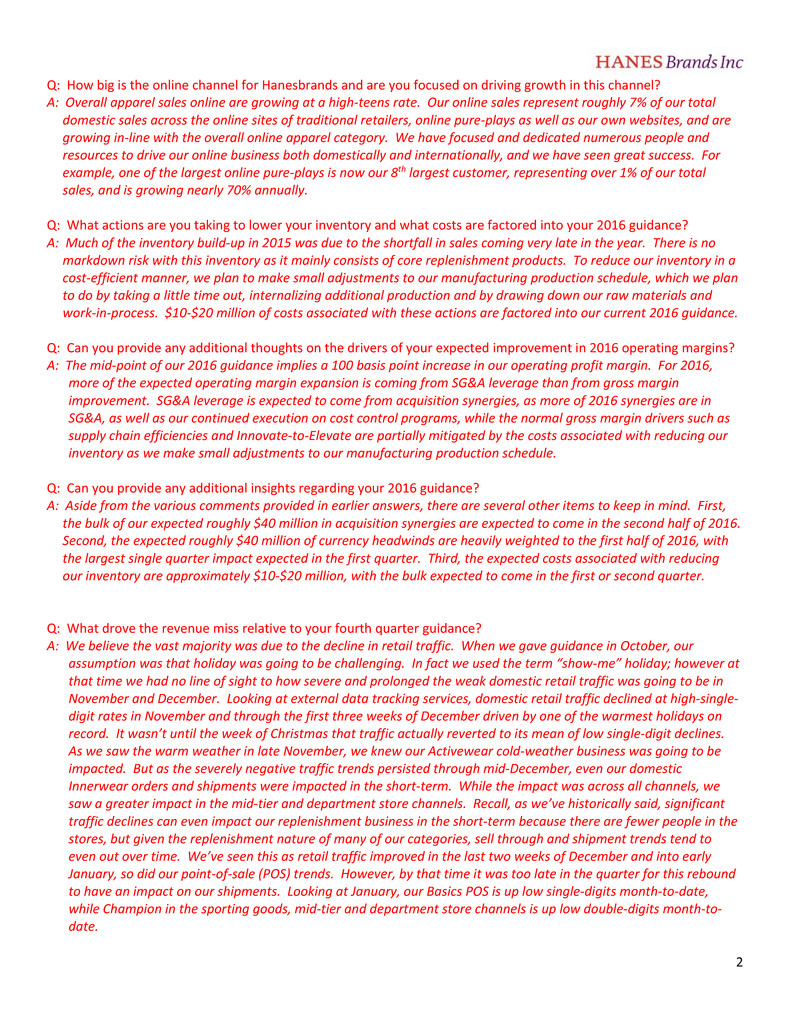
2 Q: How big is the online channel for Hanesbrands and are you focused on driving growth in this channel? A: Overall apparel sales online are growing at a high‐teens rate. Our online sales represent roughly 7% of our total domestic sales across the online sites of traditional retailers, online pure‐plays as well as our own websites, and are growing in‐line with the overall online apparel category. We have focused and dedicated numerous people and resources to drive our online business both domestically and internationally, and we have seen great success. For example, one of the largest online pure‐plays is now our 8th largest customer, representing over 1% of our total sales, and is growing nearly 70% annually. Q: What actions are you taking to lower your inventory and what costs are factored into your 2016 guidance? A: Much of the inventory build‐up in 2015 was due to the shortfall in sales coming very late in the year. There is no markdown risk with this inventory as it mainly consists of core replenishment products. To reduce our inventory in a cost‐efficient manner, we plan to make small adjustments to our manufacturing production schedule, which we plan to do by taking a little time out, internalizing additional production and by drawing down our raw materials and work‐in‐process. $10‐$20 million of costs associated with these actions are factored into our current 2016 guidance. Q: Can you provide any additional thoughts on the drivers of your expected improvement in 2016 operating margins? A: The mid‐point of our 2016 guidance implies a 100 basis point increase in our operating profit margin. For 2016, more of the expected operating margin expansion is coming from SG&A leverage than from gross margin improvement. SG&A leverage is expected to come from acquisition synergies, as more of 2016 synergies are in SG&A, as well as our continued execution on cost control programs, while the normal gross margin drivers such as supply chain efficiencies and Innovate‐to‐Elevate are partially mitigated by the costs associated with reducing our inventory as we make small adjustments to our manufacturing production schedule. Q: Can you provide any additional insights regarding your 2016 guidance? A: Aside from the various comments provided in earlier answers, there are several other items to keep in mind. First, the bulk of our expected roughly $40 million in acquisition synergies are expected to come in the second half of 2016. Second, the expected roughly $40 million of currency headwinds are heavily weighted to the first half of 2016, with the largest single quarter impact expected in the first quarter. Third, the expected costs associated with reducing our inventory are approximately $10‐$20 million, with the bulk expected to come in the first or second quarter. Q: What drove the revenue miss relative to your fourth quarter guidance? A: We believe the vast majority was due to the decline in retail traffic. When we gave guidance in October, our assumption was that holiday was going to be challenging. In fact we used the term “show‐me” holiday; however at that time we had no line of sight to how severe and prolonged the weak domestic retail traffic was going to be in November and December. Looking at external data tracking services, domestic retail traffic declined at high‐single‐ digit rates in November and through the first three weeks of December driven by one of the warmest holidays on record. It wasn’t until the week of Christmas that traffic actually reverted to its mean of low single‐digit declines. As we saw the warm weather in late November, we knew our Activewear cold‐weather business was going to be impacted. But as the severely negative traffic trends persisted through mid‐December, even our domestic Innerwear orders and shipments were impacted in the short‐term. While the impact was across all channels, we saw a greater impact in the mid‐tier and department store channels. Recall, as we’ve historically said, significant traffic declines can even impact our replenishment business in the short‐term because there are fewer people in the stores, but given the replenishment nature of many of our categories, sell through and shipment trends tend to even out over time. We’ve seen this as retail traffic improved in the last two weeks of December and into early January, so did our point‐of‐sale (POS) trends. However, by that time it was too late in the quarter for this rebound to have an impact on our shipments. Looking at January, our Basics POS is up low single‐digits month‐to‐date, while Champion in the sporting goods, mid‐tier and department store channels is up low double‐digits month‐to‐ date.
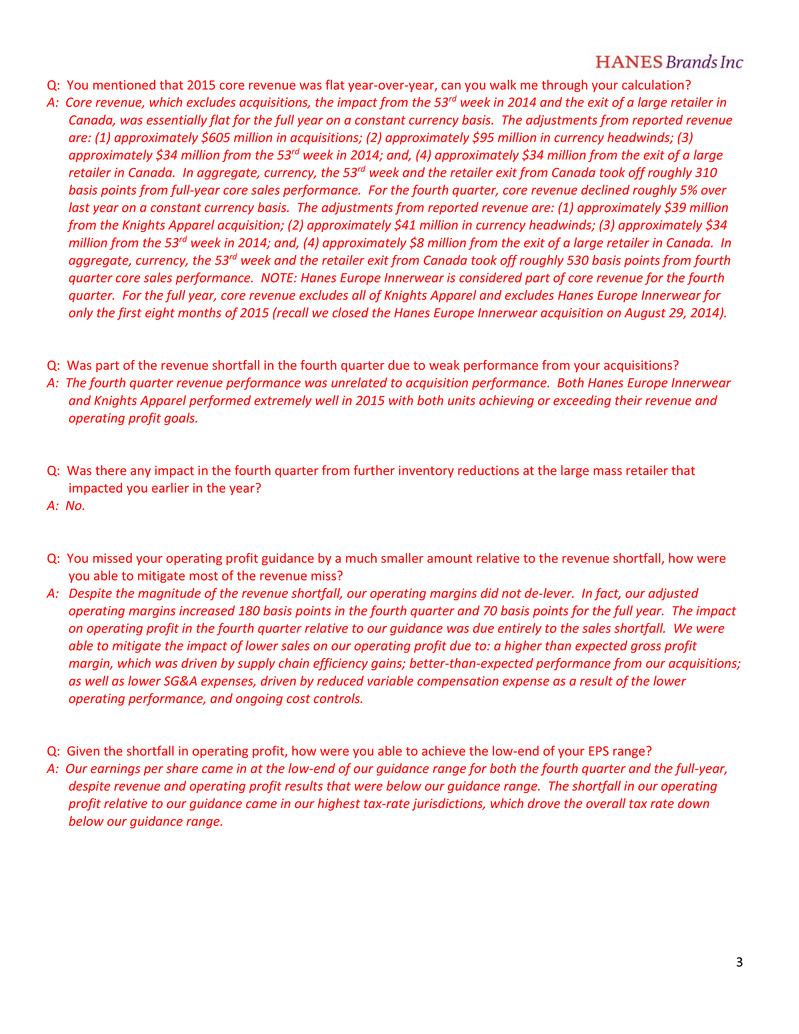
3 Q: You mentioned that 2015 core revenue was flat year‐over‐year, can you walk me through your calculation? A: Core revenue, which excludes acquisitions, the impact from the 53rd week in 2014 and the exit of a large retailer in Canada, was essentially flat for the full year on a constant currency basis. The adjustments from reported revenue are: (1) approximately $605 million in acquisitions; (2) approximately $95 million in currency headwinds; (3) approximately $34 million from the 53rd week in 2014; and, (4) approximately $34 million from the exit of a large retailer in Canada. In aggregate, currency, the 53rd week and the retailer exit from Canada took off roughly 310 basis points from full‐year core sales performance. For the fourth quarter, core revenue declined roughly 5% over last year on a constant currency basis. The adjustments from reported revenue are: (1) approximately $39 million from the Knights Apparel acquisition; (2) approximately $41 million in currency headwinds; (3) approximately $34 million from the 53rd week in 2014; and, (4) approximately $8 million from the exit of a large retailer in Canada. In aggregate, currency, the 53rd week and the retailer exit from Canada took off roughly 530 basis points from fourth quarter core sales performance. NOTE: Hanes Europe Innerwear is considered part of core revenue for the fourth quarter. For the full year, core revenue excludes all of Knights Apparel and excludes Hanes Europe Innerwear for only the first eight months of 2015 (recall we closed the Hanes Europe Innerwear acquisition on August 29, 2014). Q: Was part of the revenue shortfall in the fourth quarter due to weak performance from your acquisitions? A: The fourth quarter revenue performance was unrelated to acquisition performance. Both Hanes Europe Innerwear and Knights Apparel performed extremely well in 2015 with both units achieving or exceeding their revenue and operating profit goals. Q: Was there any impact in the fourth quarter from further inventory reductions at the large mass retailer that impacted you earlier in the year? A: No. Q: You missed your operating profit guidance by a much smaller amount relative to the revenue shortfall, how were you able to mitigate most of the revenue miss? A: Despite the magnitude of the revenue shortfall, our operating margins did not de‐lever. In fact, our adjusted operating margins increased 180 basis points in the fourth quarter and 70 basis points for the full year. The impact on operating profit in the fourth quarter relative to our guidance was due entirely to the sales shortfall. We were able to mitigate the impact of lower sales on our operating profit due to: a higher than expected gross profit margin, which was driven by supply chain efficiency gains; better‐than‐expected performance from our acquisitions; as well as lower SG&A expenses, driven by reduced variable compensation expense as a result of the lower operating performance, and ongoing cost controls. Q: Given the shortfall in operating profit, how were you able to achieve the low‐end of your EPS range? A: Our earnings per share came in at the low‐end of our guidance range for both the fourth quarter and the full‐year, despite revenue and operating profit results that were below our guidance range. The shortfall in our operating profit relative to our guidance came in our highest tax‐rate jurisdictions, which drove the overall tax rate down below our guidance range.
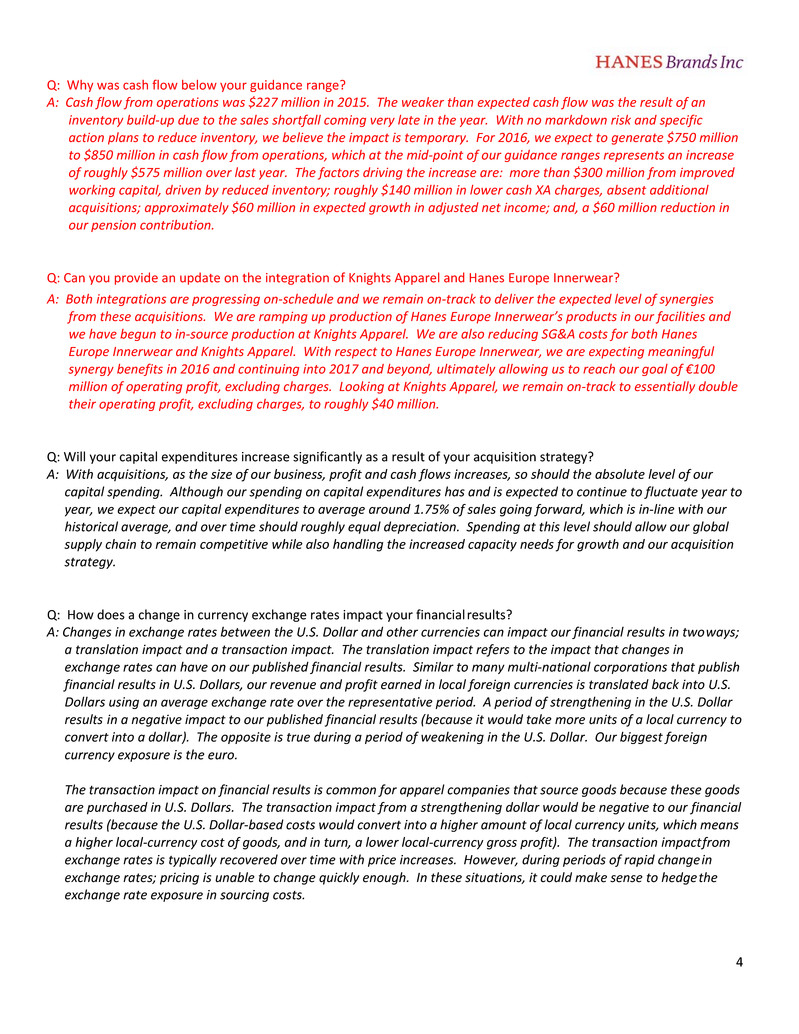
4 Q: Why was cash flow below your guidance range? A: Cash flow from operations was $227 million in 2015. The weaker than expected cash flow was the result of an inventory build‐up due to the sales shortfall coming very late in the year. With no markdown risk and specific action plans to reduce inventory, we believe the impact is temporary. For 2016, we expect to generate $750 million to $850 million in cash flow from operations, which at the mid‐point of our guidance ranges represents an increase of roughly $575 million over last year. The factors driving the increase are: more than $300 million from improved working capital, driven by reduced inventory; roughly $140 million in lower cash XA charges, absent additional acquisitions; approximately $60 million in expected growth in adjusted net income; and, a $60 million reduction in our pension contribution. Q: Can you provide an update on the integration of Knights Apparel and Hanes Europe Innerwear? A: Both integrations are progressing on‐schedule and we remain on‐track to deliver the expected level of synergies from these acquisitions. We are ramping up production of Hanes Europe Innerwear’s products in our facilities and we have begun to in‐source production at Knights Apparel. We are also reducing SG&A costs for both Hanes Europe Innerwear and Knights Apparel. With respect to Hanes Europe Innerwear, we are expecting meaningful synergy benefits in 2016 and continuing into 2017 and beyond, ultimately allowing us to reach our goal of €100 million of operating profit, excluding charges. Looking at Knights Apparel, we remain on‐track to essentially double their operating profit, excluding charges, to roughly $40 million. Q: Will your capital expenditures increase significantly as a result of your acquisition strategy? A: With acquisitions, as the size of our business, profit and cash flows increases, so should the absolute level of our capital spending. Although our spending on capital expenditures has and is expected to continue to fluctuate year to year, we expect our capital expenditures to average around 1.75% of sales going forward, which is in‐line with our historical average, and over time should roughly equal depreciation. Spending at this level should allow our global supply chain to remain competitive while also handling the increased capacity needs for growth and our acquisition strategy. Q: How does a change in currency exchange rates impact your financial results? A: Changes in exchange rates between the U.S. Dollar and other currencies can impact our financial results in two ways; a translation impact and a transaction impact. The translation impact refers to the impact that changes in exchange rates can have on our published financial results. Similar to many multi‐national corporations that publish financial results in U.S. Dollars, our revenue and profit earned in local foreign currencies is translated back into U.S. Dollars using an average exchange rate over the representative period. A period of strengthening in the U.S. Dollar results in a negative impact to our published financial results (because it would take more units of a local currency to convert into a dollar). The opposite is true during a period of weakening in the U.S. Dollar. Our biggest foreign currency exposure is the euro. The transaction impact on financial results is common for apparel companies that source goods because these goods are purchased in U.S. Dollars. The transaction impact from a strengthening dollar would be negative to our financial results (because the U.S. Dollar‐based costs would convert into a higher amount of local currency units, which means a higher local‐currency cost of goods, and in turn, a lower local‐currency gross profit). The transaction impact from exchange rates is typically recovered over time with price increases. However, during periods of rapid change in exchange rates; pricing is unable to change quickly enough. In these situations, it could make sense to hedge the exchange rate exposure in sourcing costs.

5 Knights Apparel‐related FAQ Q: How much did the Knights Apparel acquisition contribute to your 2015 results? A: For the full‐year 2015, Knights Apparel generated approximately $160 million in revenue and approximately $27 million in operating profit, excluding charges. This compared to our prior guidance of approximately $160 million in sales and approximately $22 million in operating profit, excluding charges. In the second quarter, Knights Apparel contributed approximately $37 million in revenue and approximately $5 million in operating profit, excluding charges. In the third quarter, Knights Apparel contributed approximately $84 million in revenue and approximately $16 million in operating profit, excluding charges. In the fourth quarter, Knights Apparel contributed approximately $39 million in revenue and approximately $6.5 million in operating profit, excluding charges. Q: What is the expected financial contribution of the Knights Apparel acquisition? A: Once synergies are fully realized, which we estimate will be within two to three years of the acquisition close, and excluding charges, we believe Knights Apparel should annually add over $180 million to sales, approximately $40 million to operating profit, and approximately $40 million to cash flow from operations. Q: What is the expected return for this acquisition? A: Based on the purchase price of roughly $200 million, this transaction is valued at roughly 8 times estimated 2015 EBITDA, but post synergies, we expect this multiple to drop to roughly 4 ½ times and deliver an after‐tax IRR in the high‐ teens. Q: How confident are you that you will be able to achieve the $40 million of operating profit, excluding charges, within two to three years of the acquisition close and where are the synergies coming from? A: We believe we can deliver approximately $40 million in operating profit, excluding charges, within two to three years of the acquisition close. The sources of synergies include: (1) leveraging the collegiate licensing and graphic art capabilities of our Gear For Sports business; (2) leveraging the strength and expertise of our mass channel business; (3) leveraging our global supply chain and gaining scale from reducing third‐party sourcing and decoration; and, (4) eliminating duplicative stand‐alone company costs. Q: How will their business fit into your global supply chain? A: We see their business fitting into our low‐cost, company‐owned supply chain in two ways. First, they secure blank t‐ shirts and sweatshirts in the open market that we can supply directly. Second, they outsource their graphic art and printing, which we can integrate into our low‐cost printing operations in Honduras, or in the case of short lead time products, into our quick‐turn operations in Lenexa, Kansas and Reynosa, Mexico. Q: Can you provide any insight into Knights Apparel’s business operations? A: Knights Apparel is a leading supplier of licensed collegiate sports apparel, predominantly in the mass channel. Knights Apparel has licenses with over 400 colleges and universities, including exclusive arrangements with a significant majority of the top 50 selling schools (as measured by logo apparel sales). They also have a small position in professional sports licensed apparel in the mass channel. Their business is replenishment in nature and they currently source all of their apparel and graphic printing needs. Knights Apparel’s leading collegiate apparel position in the mass retail channel is a great complement to Gear For Sports’ leading collegiate apparel position in the college bookstore channel.
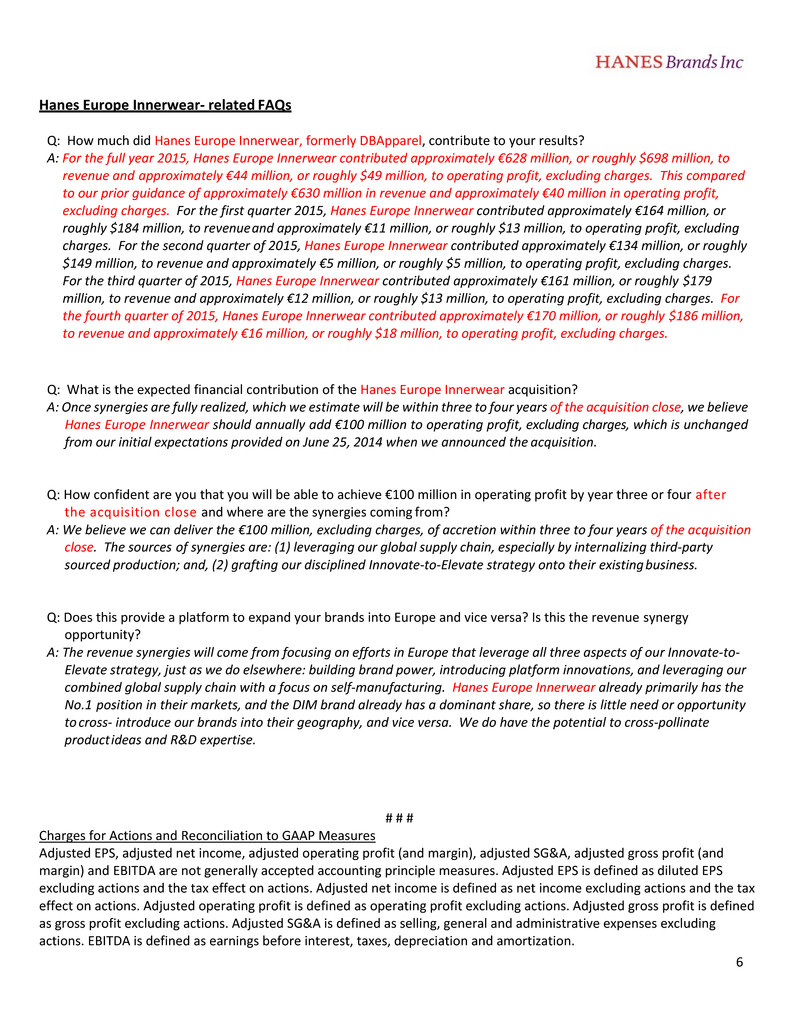
6 Hanes Europe Innerwear‐ related FAQs Q: How much did Hanes Europe Innerwear, formerly DBApparel, contribute to your results? A: For the full year 2015, Hanes Europe Innerwear contributed approximately €628 million, or roughly $698 million, to revenue and approximately €44 million, or roughly $49 million, to operating profit, excluding charges. This compared to our prior guidance of approximately €630 million in revenue and approximately €40 million in operating profit, excluding charges. For the first quarter 2015, Hanes Europe Innerwear contributed approximately €164 million, or roughly $184 million, to revenue and approximately €11 million, or roughly $13 million, to operating profit, excluding charges. For the second quarter of 2015, Hanes Europe Innerwear contributed approximately €134 million, or roughly $149 million, to revenue and approximately €5 million, or roughly $5 million, to operating profit, excluding charges. For the third quarter of 2015, Hanes Europe Innerwear contributed approximately €161 million, or roughly $179 million, to revenue and approximately €12 million, or roughly $13 million, to operating profit, excluding charges. For the fourth quarter of 2015, Hanes Europe Innerwear contributed approximately €170 million, or roughly $186 million, to revenue and approximately €16 million, or roughly $18 million, to operating profit, excluding charges. Q: What is the expected financial contribution of the Hanes Europe Innerwear acquisition? A: Once synergies are fully realized, which we estimate will be within three to four years of the acquisition close, we believe Hanes Europe Innerwear should annually add €100 million to operating profit, excluding charges, which is unchanged from our initial expectations provided on June 25, 2014 when we announced the acquisition. Q: How confident are you that you will be able to achieve €100 million in operating profit by year three or four after the acquisition close and where are the synergies coming from? A: We believe we can deliver the €100 million, excluding charges, of accretion within three to four years of the acquisition close. The sources of synergies are: (1) leveraging our global supply chain, especially by internalizing third‐party sourced production; and, (2) grafting our disciplined Innovate‐to‐Elevate strategy onto their existing business. Q: Does this provide a platform to expand your brands into Europe and vice versa? Is this the revenue synergy opportunity? A: The revenue synergies will come from focusing on efforts in Europe that leverage all three aspects of our Innovate‐to‐ Elevate strategy, just as we do elsewhere: building brand power, introducing platform innovations, and leveraging our combined global supply chain with a focus on self‐manufacturing. Hanes Europe Innerwear already primarily has the No.1 position in their markets, and the DIM brand already has a dominant share, so there is little need or opportunity to cross‐ introduce our brands into their geography, and vice versa. We do have the potential to cross‐pollinate product ideas and R&D expertise. # # # Charges for Actions and Reconciliation to GAAP Measures Adjusted EPS, adjusted net income, adjusted operating profit (and margin), adjusted SG&A, adjusted gross profit (and margin) and EBITDA are not generally accepted accounting principle measures. Adjusted EPS is defined as diluted EPS excluding actions and the tax effect on actions. Adjusted net income is defined as net income excluding actions and the tax effect on actions. Adjusted operating profit is defined as operating profit excluding actions. Adjusted gross profit is defined as gross profit excluding actions. Adjusted SG&A is defined as selling, general and administrative expenses excluding actions. EBITDA is defined as earnings before interest, taxes, depreciation and amortization.
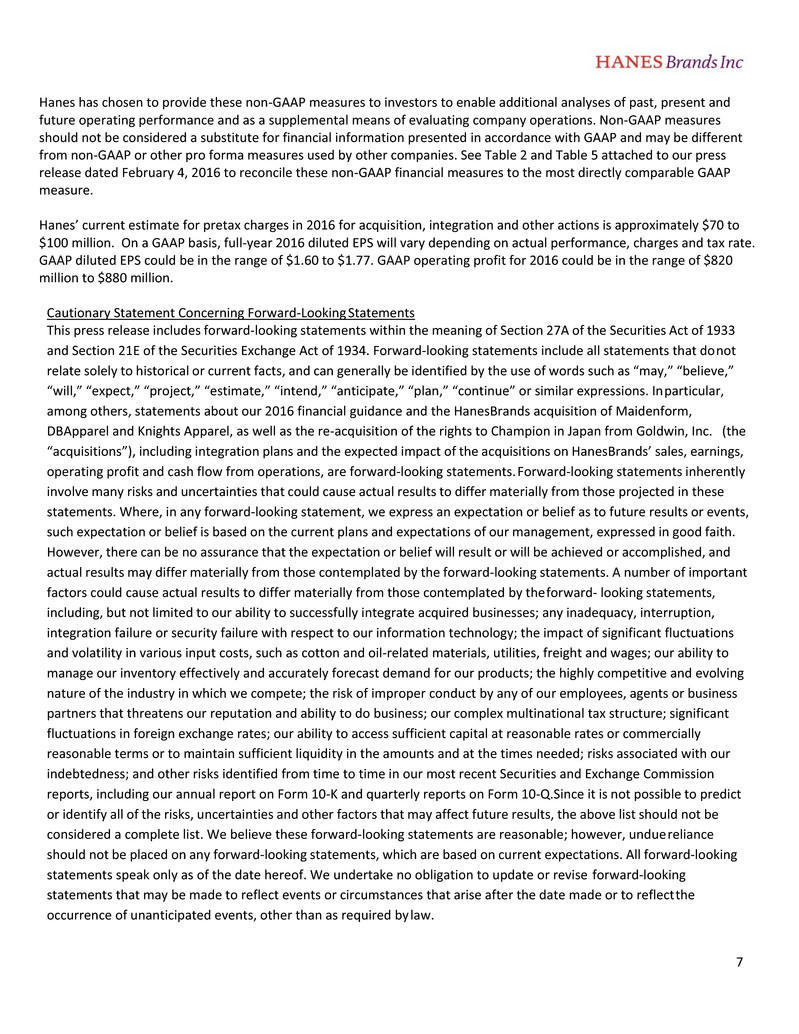
7 Hanes has chosen to provide these non‐GAAP measures to investors to enable additional analyses of past, present and future operating performance and as a supplemental means of evaluating company operations. Non‐GAAP measures should not be considered a substitute for financial information presented in accordance with GAAP and may be different from non‐GAAP or other pro forma measures used by other companies. See Table 2 and Table 5 attached to our press release dated February 4, 2016 to reconcile these non‐GAAP financial measures to the most directly comparable GAAP measure. Hanes’ current estimate for pretax charges in 2016 for acquisition, integration and other actions is approximately $70 to $100 million. On a GAAP basis, full‐year 2016 diluted EPS will vary depending on actual performance, charges and tax rate. GAAP diluted EPS could be in the range of $1.60 to $1.77. GAAP operating profit for 2016 could be in the range of $820 million to $880 million. Cautionary Statement Concerning Forward‐Looking Statements This press release includes forward‐looking statements within the meaning of Section 27A of the Securities Act of 1933 and Section 21E of the Securities Exchange Act of 1934. Forward‐looking statements include all statements that do not relate solely to historical or current facts, and can generally be identified by the use of words such as “may,” “believe,” “will,” “expect,” “project,” “estimate,” “intend,” “anticipate,” “plan,” “continue” or similar expressions. In particular, among others, statements about our 2016 financial guidance and the HanesBrands acquisition of Maidenform, DBApparel and Knights Apparel, as well as the re‐acquisition of the rights to Champion in Japan from Goldwin, Inc. (the “acquisitions”), including integration plans and the expected impact of the acquisitions on HanesBrands’ sales, earnings, operating profit and cash flow from operations, are forward‐looking statements. Forward‐looking statements inherently involve many risks and uncertainties that could cause actual results to differ materially from those projected in these statements. Where, in any forward‐looking statement, we express an expectation or belief as to future results or events, such expectation or belief is based on the current plans and expectations of our management, expressed in good faith. However, there can be no assurance that the expectation or belief will result or will be achieved or accomplished, and actual results may differ materially from those contemplated by the forward‐looking statements. A number of important factors could cause actual results to differ materially from those contemplated by the forward‐ looking statements, including, but not limited to our ability to successfully integrate acquired businesses; any inadequacy, interruption, integration failure or security failure with respect to our information technology; the impact of significant fluctuations and volatility in various input costs, such as cotton and oil‐related materials, utilities, freight and wages; our ability to manage our inventory effectively and accurately forecast demand for our products; the highly competitive and evolving nature of the industry in which we compete; the risk of improper conduct by any of our employees, agents or business partners that threatens our reputation and ability to do business; our complex multinational tax structure; significant fluctuations in foreign exchange rates; our ability to access sufficient capital at reasonable rates or commercially reasonable terms or to maintain sufficient liquidity in the amounts and at the times needed; risks associated with our indebtedness; and other risks identified from time to time in our most recent Securities and Exchange Commission reports, including our annual report on Form 10‐K and quarterly reports on Form 10‐Q.Since it is not possible to predict or identify all of the risks, uncertainties and other factors that may affect future results, the above list should not be considered a complete list. We believe these forward‐looking statements are reasonable; however, undue reliance should not be placed on any forward‐looking statements, which are based on current expectations. All forward‐looking statements speak only as of the date hereof. We undertake no obligation to update or revise forward‐looking statements that may be made to reflect events or circumstances that arise after the date made or to reflect the occurrence of unanticipated events, other than as required by law.






